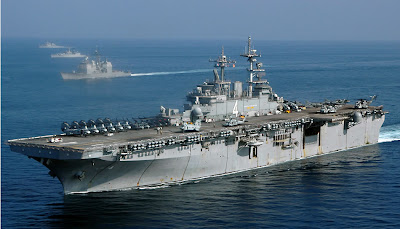.jpg)
Above is the USS Wasp, the first of the Wasp-class Amphibious Assault Ships. These ships are designed to land forces on a hostile shore and support them. They are the largest such ships in the world and in many ways, are more powerful than the aircraft carriers of other nations and aircraft carriers from the past. The Wasp-class has the ability to launch surface craft from its rear well deck and can also launch helicopters and AV-8B Harrier II STOL aircraft from its flight deck. Sometimes the LHD will carry as many as 20 Harriers when it is configured as a "Harrier Carrier" with a narrower focus on close air support of ground forces.
The LHD launches LCACs (Landing Craft, Air-Cushioned - hovercraft) and LCUs (Landing Craft Utility) to ferry Marines and supplies to the store. They can also launch the AAVs (Amphibious Assault Vehicles). To further support operations on shore, every Wasp-class warship has a hospital with 600 patient beds and six operating rooms.
The Wasp-class is descended from the earlier Tarawa-class. The main differences are that the Wasp is longer to fit the LCAC and does not have the 5 inch guns of the Tarawa-class. These ships are named after famous battles of the United States Marine Corps or for WWII aircraft carriers. The entire Wasp-class of eight ships was built at the Ingalls Shipbuilding Co. in Pascagoula, Mississippi, the USS Wasp being commissioned on July 30, 1989.

| General characteristics | |
|---|---|
| Class and type: | amphibious assault ship |
| Displacement: | Approx. 40,500 tons (41,150 metric tons) full load |
| Length: | 844 ft (257 m) |
| Beam: | 106 ft (32 m) |
| Propulsion: | Two boilers, two geared steam turbines, two shafts, 70,000 shaft-horsepower (52 megawatt); but two General Electric LM2500 geared gas turbines, two shafts on the USS Makin Island) |
| Speed: | 20 knots (37 km/h) |
| Complement: | 104 officers, 1,004 enlisted 1,894 Marine Detachment |
| Armament: | Two Rolling Airframe Missile launchers Two Sea Sparrow missile launchers Three 20 mm Phalanx CIWS systems (LHD 5-7 with two) Four .50 BMG machine guns Four 25 mmMk 38 chain guns (LHD 5-7 with three). |
| Aircraft carried: | Actual mix depends upon the mission[1] Standard Complement 6 AV-8B Harrier II attack aircraft 4 AH-1W SuperCobra attack helicopter 12 CH-46 Sea Knight helicopters 4 CH-53 Sea Stallion helicopters 3 UH-1N Huey helicopters OR Assault 42 CH-46 Sea Knight helicopters OR Sea Control 20 AV-8B Harrier II attack aircraft 6 SH-60F/HH-60H ASW helicopters |















































